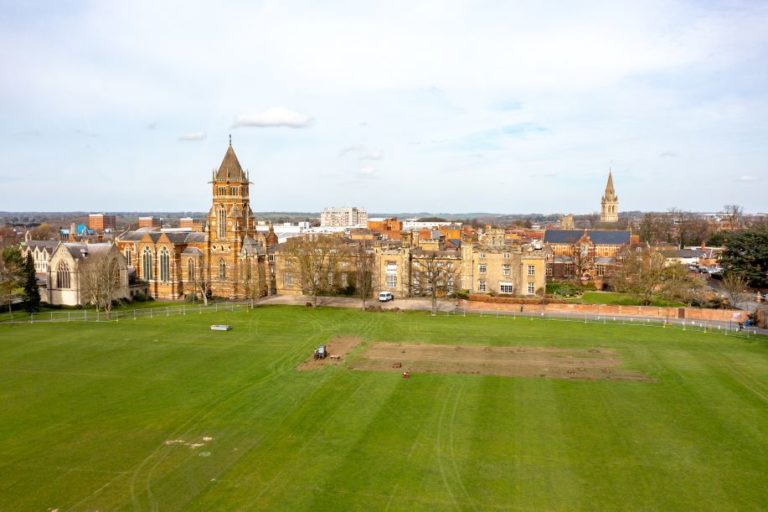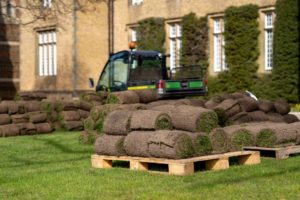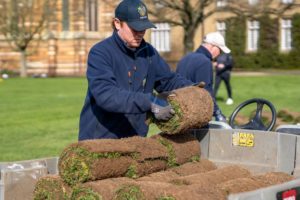After almost 200 years of sporting legacy, one of England’s most famous independent schools, Rugby School, has come to the decision that now is the right time to re-lay the historic turf of The Close – the school’s main sports pitch. The project will see the original soil-based turf lifted to make way for a sand-based alternative that will deliver the highest levels of performance in the years to come.
The Close at Rugby School is one of the most iconic sporting sites in the world. When William Webb Ellis decided to pick up the ball during a game of soccer at the school back in 1823, the distinct handling game of rugby football was invented. The field on which this historic moment occurred stood strong until this year, when the school made the decision to re-turf the pitch.
Rugby was first introduced to the United States in the late 1800s by Americans who had been educated in English schools. Following its introduction into American universities, the momentum of rugby began to seriously grow in the United States in the late 1950s, into the ‘60s and ‘70s, as many colleges formed structured teams. The next 20 years saw the introduction of a college national championship tournament, and a U.S. national team that would compete in the inaugural Rugby World Cup.
In the 1990s, rugby union became officially professional on a global level. However, it wasn’t until 2015 that the USA had a professional rugby organization. In 2017, Major League Rugby was officially born. With a large CBS television agreement, the first season got underway in 2018, with the league continuing to grow in size and stature each year. Today, rugby is one of the fastest-growing sports in the United States.
Back in England, James Mead, head groundsman at Rugby School, has been heading up this historic project, and cited increased pressure on the pitches and changes in extremes of weather in the United Kingdom as the foremost causes of the need for change.
“Mr. Ellis picked up the ball and ran with it in 1823, and from there on every pupil and teacher that has been to, and left, the school has carried the game around the world with them. We are proud to say that the incredible world rugby family that exists today all started from this very ground,” said Mead.
“From that day almost 200 years ago until 2022, The Close remained a soil-based pitch. Over those years we have maintained the fields to the highest possible level with the equipment we have at our disposal,” Mead added. “However, we are now at a point, with the extremes of weather and changes to nature we are experiencing, that we have to look at the performance of the pitch for the next 200 years. So, we will be installing an entirely sand-based pitch with a brand-new drainage and irrigation system that will deliver the very highest levels of performance all 12 months of the year.”
Said Mead, “This is a huge project for us. It has been in the planning for about five years now, since we really started to notice a couple of changes in the way the British weather was affecting the pitch. Through no fault of our own, the performance of The Close wasn’t quite at the level we wanted or needed it to be. So, we started to think about how we could combat the changes in precipitation and temperature to take things forward, and what the best methods to accomplish that might be. We were always very conscious that we wanted to keep the look of the pitch natural, so the overall appearance of The Close won’t change much, but will be far more refined with the sand base to deliver all-weather performance. Most importantly, with a sand base, the new pitch will be much more efficient from a management perspective, and the new drainage system will have a huge impact in the wetter months.
“We are always looking to host more and more prestigious sporting events, so the ground has to undergo a lot of stress throughout a year,” Mead added. “The level of those tournaments and the expression that we must portray of the school and its facilities is extremely high, so the pitch must resemble that on any given day.”
Involved with the project is Bernhard and Company, a supplier of grinding machines and turf care solutions, which has helped ensure that the playing surfaces at Rugby School are some of the best in the country, and will also play a part in maintaining the new turf once it starts to grow through. Bernhard and Company has a 20-plus-year business relationship with Rugby School, but the link between the two organizations dates back even further, with the Bernhard and Company based just a stone’s throw from the school.
With a brand-new sand-based pitch being laid, blade sharpening will be more important than ever. Mowers will be consistently subjected to sand damage, so the blades will need to be ground on a regular basis in order to ensure the new grass plant is not ripped or damaged when cut.
Steven Nixon, managing director of Bernhard and Company, said, “Anybody who’s involved in sports turf at any level wants the best possible surfaces, for many reasons. We want the pitch to look good, it has to play well, and it also has to be safe for the athletes and players that are going to be performing on it. So, having a pitch that is maintained to the highest possible standard, with a healthy grass plant and rootzone, is absolutely crucial. Having the grinding machines on site will be hugely beneficial when the time comes to start cutting the grass again.
“For Rugby School, having world-class sports fields is a huge part of their program,” Nixon added. “When people are looking at the school as an option, they want to look at the facilities and understand what kind of surfaces they’re going to be playing sport on and how good they are. The surfaces here should be as good as any in the country. We’re excited to continue working with Rugby School as it takes on this massive project to completely overhaul the base of the pitch at The Close.”
The team at Rugby School did not simply remove and discard the turf from The Close. With such a decorated history, it seemed only appropriate that rugby fans in the United Kingdom were offered the chance to purchase their very own piece of sporting legacy.
“The home of any sport is very important, and to have it in its virtual natural state for almost 200 years is an incredible thing,” said Mead. “This was a truly one-off project; there will never again be an opportunity to preserve a piece of the original rugby turf. We decided that to not give rugby fans the opportunity to purchase an original piece of The Close to plant at their home would almost be criminal! And it turns out we were right, as every strip sold out in a matter of days – it’s a nice feeling knowing that this historical turf will live on in various forms around the country with people who possess a genuine passion for the game that was created here.”
Article provided by Bernhard and Company.





